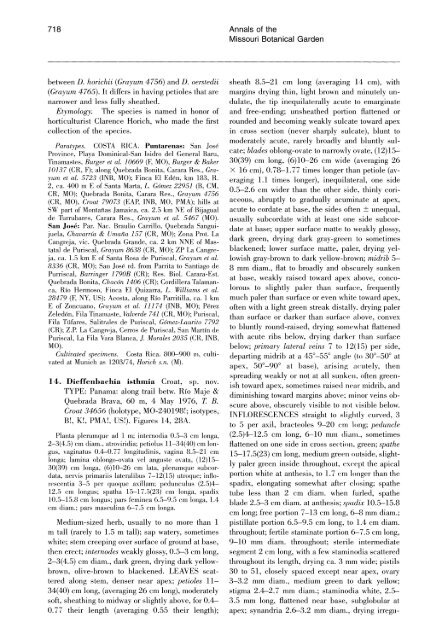l - CNCFlora
l - CNCFlora
l - CNCFlora
You also want an ePaper? Increase the reach of your titles
YUMPU automatically turns print PDFs into web optimized ePapers that Google loves.
718 Annals of the<br />
Missouri Botanical Garden<br />
between D. horichii (Grayum 4756) and D. oerstedii sheath 8.5-21 cm long (averaging 14 cm), with<br />
(Grayum 4765). It differs in having petioles that are margins drying thin, light brown and minutely unnarrower<br />
and less fully sheathed.<br />
dulate, the tip inequilaterally acute to emarginate<br />
Etymology. The species is named in honor of and free-ending; unsheathed portion flattened or<br />
horticulturist Clarence Horich, who made the first rounded and becoming weakly sulcate toward apex<br />
collection of the species.<br />
in cross section (never sharply sulcate), blunt to<br />
Paratypes. COSTA RICA. Puntarenas: San Jose<br />
Province, Playa Dominical-San Isidro del General Baru,<br />
'rinamastes, Burger et al. 10669 (F, MO), Burger & Baker<br />
10137 (CR, F), along Quebrada Bonita, Carara Res., Grayum<br />
et al. 5723 (INB, MO), Finca E1 Eden, km 183, R.<br />
2, ca. 400 m E of Santa Marta, L. G6mez 22951 (B, CM,<br />
CR, MO); Quebrada Bonita, Carara Res., Grayun 4756<br />
(CR, MO), Croat 79073 (EAP, INB, MO, PMA), hills at<br />
SW part of Montanas Jamaica, ca. 2.5 km NE of Bijagual<br />
moderately acute, rarely broadly and bluntly sulcate;<br />
blades oblong-ovate to narrowly ovate, (12)15-<br />
30(39) cm long, (6)10-26 cm wide (averaging 26<br />
x 16 cm), 0.78-1.77 times longer than petiole (averaging<br />
1.1 times longer), inequilateral, one side<br />
0.5-2.6 cm wider than the other side thinly coriaceous,<br />
abruptly to gradually acuminate at apex,<br />
acute to cordate at base, the sides often + unequal,<br />
de Turrubares, Carara Res., Grayu1m et al. 5467 (MO). usually subcordate with at least one side subcor-<br />
San Jose: Par. Nac. Braulio Carrillo, Quebrada Sanguijuela,<br />
Chavarrfa & Untana 157 (CR, MO), Zona Prot. La<br />
Cangreja, vic. Quebrada Grande, ca. 2 km NNE of Mastatal<br />
de Puriscal, Grayun 8638 (CR, MO), ZP La Cangreja,<br />
ca. 1.5 km E of Santa Rosa de Puriscal, Grayun et al.<br />
8336 (CR, MO), San Jose rd. from Parrita to Santiago de<br />
Purriscal, Barringer 1790B (CR), Res. Biol. Carara-Est.<br />
Quebrada Bonita, Chac6n 1406 (CR), Cordillera Talamanca,<br />
Rfo Hermoso, Finca E1 Quizarra, L. Willianes et al.<br />
28479 (F, NY, US); Acosta, along Rfo Parritilla, ca. 1 km<br />
date at base; upper surface matte to weakly glossy,<br />
dark green, drying dark gray-green to sometimes<br />
blackened; lower surface matte, paler, drying yellowish<br />
gray-brown to dark yellow-brown; midrib 5-<br />
8 mm diam., flat to broadly and obscurely sunken<br />
at base, weakly raised toward apex above, concolorous<br />
to slightly paler than surface, frequently<br />
much paler than surface or even white toward apex,<br />
E of Zoncuano, Grflyum el al. 11174 (INB, MO); Perez<br />
Zeled6n, Fila Tinanlaste, Valverde 741 (CR, MO); Puriscal,<br />
Fila Tufares, Salitrclles de Puriscal, Goncez-Laurito 7792<br />
(CR); Z.P. La Cangreja, Cerros de Puriscal, San Martfn de<br />
Puriscal, La Fila Vala Blanca, J. Morales 2035 ((21t, INB,<br />
MO).<br />
Cultivated specimens. Costa Rica. 800-900 z1, cultivated<br />
at Munich as 1203/74, Horich s.n. (M).<br />
often with a light green streak distally! drying paler<br />
than surface or darker than surface al)ove, convex<br />
to bluntly round-raised, drying somewhat flattened<br />
with acute ribs below, drying darkel than surface<br />
below; primary lateral veins 7 to 12(15) per side,<br />
departing midrib at a 45°-55° angle (to 30°-50° at<br />
apex, 50°-90° at base), arising a( utely, then<br />
14. Dieffenbachia isthlnia Croat, sp. nov.<br />
TYPE: Panama: along trail betw. Rfo Maje &<br />
Quebrada Brava, 60 m, 4 May 1976, 1: B.<br />
Croat 34656 (holotype, M0-240198!; isotypes,<br />
B!, K!, PMA!, US!). Figures 14, 28A.<br />
spreading weakly or not at all sunkell often greenish<br />
toward apex, sometimes raise(l 1leal midrib, and<br />
diminishing toward margins above; lllinor veins obscure<br />
above, obscurely visible to not visible below.<br />
INFLORESCENCES straight to sliglltly curved, 3<br />
to 5 per axil, bracteoles 9-20 cm long; peduncle<br />
Planta<br />
2-3(4.5)<br />
plerumque<br />
cm diam.,<br />
ad 1 m,<br />
atroviridia;<br />
internodia<br />
petiolus<br />
0.5-3<br />
11-34(40)<br />
cm longa,<br />
cm lon-<br />
(2.5)4-12.5 cm long, 6-10 mm diall., sometimes<br />
flattened on one side in cross sec.ti(-)n, green; spathe<br />
gus, vaginatus 0.4-0.77 longitudinis, vagina 8.5-21 cm 15-17.5(23) cm long, medium green outside, slightlonga,<br />
lamina oblongo-ovata vel anguste ovata, (12)15-<br />
30(39) cm longa, (6)10-26 cm lata, plerumque subcordata,<br />
nervis primariis lateralibus 7-12(15) utroque, inflorescentia<br />
3-5 per quoque axillam; pedunculus (2.5)4ly<br />
paler green inside throughout, except the apical<br />
portion white at anthesis, to 1.7 c m lollger than the<br />
spadix, elongating somewhat after closing; spathe<br />
12.5 cm longus, spatha 15-17.5(23) cm longa, spadix tube less than 2 cm diam. when furled, spathe<br />
10.5-15.8 cm longus; pars feminea 6.5-9.5 cm longa, 1.4 blade 2.5-3 cm diam. at anthesis; s)

















